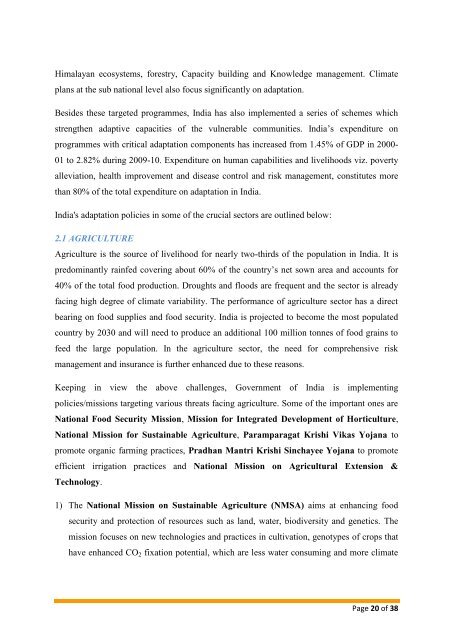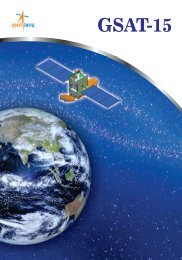INDIA’S INTENDED NATIONALLY DETERMINED CONTRIBUTION
1WsYDcS
1WsYDcS
You also want an ePaper? Increase the reach of your titles
YUMPU automatically turns print PDFs into web optimized ePapers that Google loves.
Himalayan ecosystems, forestry, Capacity building and Knowledge management. Climate<br />
plans at the sub national level also focus significantly on adaptation.<br />
Besides these targeted programmes, India has also implemented a series of schemes which<br />
strengthen adaptive capacities of the vulnerable communities. India’s expenditure on<br />
programmes with critical adaptation components has increased from 1.45% of GDP in 2000-<br />
01 to 2.82% during 2009-10. Expenditure on human capabilities and livelihoods viz. poverty<br />
alleviation, health improvement and disease control and risk management, constitutes more<br />
than 80% of the total expenditure on adaptation in India.<br />
India's adaptation policies in some of the crucial sectors are outlined below:<br />
2.1 AGRICULTURE<br />
Agriculture is the source of livelihood for nearly two-thirds of the population in India. It is<br />
predominantly rainfed covering about 60% of the country’s net sown area and accounts for<br />
40% of the total food production. Droughts and floods are frequent and the sector is already<br />
facing high degree of climate variability. The performance of agriculture sector has a direct<br />
bearing on food supplies and food security. India is projected to become the most populated<br />
country by 2030 and will need to produce an additional 100 million tonnes of food grains to<br />
feed the large population. In the agriculture sector, the need for comprehensive risk<br />
management and insurance is further enhanced due to these reasons.<br />
Keeping in view the above challenges, Government of India is implementing<br />
policies/missions targeting various threats facing agriculture. Some of the important ones are<br />
National Food Security Mission, Mission for Integrated Development of Horticulture,<br />
National Mission for Sustainable Agriculture, Paramparagat Krishi Vikas Yojana to<br />
promote organic farming practices, Pradhan Mantri Krishi Sinchayee Yojana to promote<br />
efficient irrigation practices and National Mission on Agricultural Extension &<br />
Technology.<br />
1) The National Mission on Sustainable Agriculture (NMSA) aims at enhancing food<br />
security and protection of resources such as land, water, biodiversity and genetics. The<br />
mission focuses on new technologies and practices in cultivation, genotypes of crops that<br />
have enhanced CO 2 fixation potential, which are less water consuming and more climate<br />
Page 20 of 38



